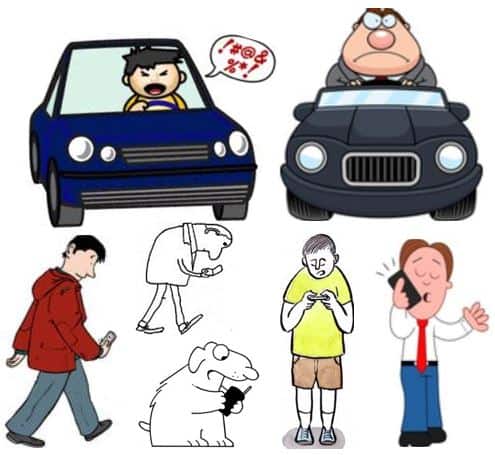Ground level traffic lights will be introduced at some crossings in New South Wales, Australia, to see whether the number of mobile phone addicts run over by vehicles declines. More and more people in Australia, and much of the rest of the world, are walking and texting at the same time, many continue staring at their tiny screens even while crossing the road.
The New South Wales (NSW) Government says the trial, the first in Australia, aims to help keep distracted mobile phone users safer on the roads of Sydney.
Many pedestrians are not looking up from their mobiles before stepping onto the road, relying instead on their herd instinct of moving when the crowd does.
 Did you know that staring at your smartphone while strolling down the street could land you in an embarrassing, dangerous or even fatal situation?
Did you know that staring at your smartphone while strolling down the street could land you in an embarrassing, dangerous or even fatal situation?
These new lights will function in the same way as regular pedestrian crossing lights, but they will be at ground level, and will hopefully reduce the number of texters who are hit by vehicles and either die or get seriously injured.
Six-month trial
The six-month trial, which will cost the Australian taxpayer AU$250,000, will begin in December 2016.
The city of Augsburg in Swabia, Bavaria, Germany, is in the middle of a similar trial which started in April this year.
Duncan Gay, NSW Government’s Minister for Roads, Maritime and Freight, says he is not keen on resorting to ‘hand-holding’ measures. However, “if these lights could save just one life, I’ll do it,” he added.
One wonders how saving a life will be measured. How can you tell that a particular pedestrian would have died at that moment had the ground level lights not been there? If the total for the six month period declines, couldn’t that just be a blip? Wouldn’t they need statistics – gather and analyze numerical data in large quantities – over a longer period?
 Should the taxpayer be landed with the bill for making mobile phone users safer when they are walking in the streets, or is it the pedestrian’s responsibility so see where he or she is going and what’s coming?
Should the taxpayer be landed with the bill for making mobile phone users safer when they are walking in the streets, or is it the pedestrian’s responsibility so see where he or she is going and what’s coming?
The ground-level traffic lights will be installed across five sites in Sydney’s central business district.
According to a road toll update published earlier this week, sixty-seven pedestrians were killed in NSW in the 12-month period ending 31 May 2016, compared to 44 during the previous twelve-month period – that’s an increase of 50%.
Is this going too far?
Many people say that what the NSW Government is doing is wrong. Rather than pander to the lack of consideration of the mobile phone-texting pedestrian, it should seek ways to correct the irresponsible behaviour.
If you are caught texting while walking in the street in the US state of Idaho, you are liable to an instant $50 fine.
Surely, it is the responsibility of the pedestrian to cross the road safely, and not the taxpayers’ to make his or her life safer, many people believe.
 Using your mobile phone while walking in the streets could endanger your and other people’s lives – a driver might swerve to avoid you and hit somebody else. So shouldn’t the same rules apply to both pedestrians and drivers?
Using your mobile phone while walking in the streets could endanger your and other people’s lives – a driver might swerve to avoid you and hit somebody else. So shouldn’t the same rules apply to both pedestrians and drivers?
A study carried out by researchers at Ohio State University found that the number of people treated in US emergency rooms for injuries related to using a mobile phone while walking increased by 100% from 2005 to 2010.
This increase went against the trend for the total number of pedestrian injuries for any reason, which over the same period had declined.
Jack Nasar, co-author of the study and professor of city and regional planning, said:
“The role of cell phones in distracted driving injuries and deaths gets a lot of attention and rightly so, but we need to also consider the danger cell phone use poses to pedestrians.”
More injuries from talking that texting
People most likely to use their mobile phone while walking in the street and to suffer an injury are aged between 16 and 25, the study found. They were surprised to find that in most cases, the user was talking rather than texting.
11 teens die every day from #texting and driving: https://t.co/ODZSd05gld pic.twitter.com/cwL1vldEHg
— Rawhide Boys Ranch (@rawhideinc) May 26, 2016
Types of injuries reported vary considerably. In one case, a 14-year old boy was walking along the street while talking on his mobile when he fell eight feet off a bridge into a rocky ditch – he suffered serious shoulder and chest injuries.
A young man (23) was hit by a car while walking in the middle line of a road and talking on his phone – he injured his hip.
Prof. Nasar believes the total number of mobile phone related injuries is probably much higher than what we read in official statistics. Not every person who is injured goes to an emergency room, while others may leave out the bit about being on the phone when they explain what had happened to them. In the US and many other countries, uninsured people may decide to treat themselves.
Surprisingly, in the US, talking on the phone accounted to around 69% of injuries, while texting accounted for just 9%.
#Distracted Pedestrians = Cause of Car Accidents Now. Plz Take Off the Headphones & Look. #yyj http://t.co/aXuUy8nzY1 pic.twitter.com/mPCyDB8Fpq
— Searle’s Auto Repair (@SearlesAuto) October 6, 2014
Prof. Nasar does not think texting is safer than talking on the phone while walking in the street. The lower figure for texting is because considerably fewer people text while walking compared to talking while walking.
Experts globally warn that the problem with distracted pedestrians will probably get worse.
Prof. Nasar said:
“As more people get cell phones and spend more time using them, the number of injuries is likely to increase as well. Now people are playing games and using social media on their phones too.”
He believes that the best way to reduce these numbers is to begin changing norms to mobile phone use in our society – and that begins with parents.
“Parents already teach their children to look both ways when crossing the street. They should also teach them to put away their cell phone when walking, particularly when crossing a street,” he said.
Video – What if all pedestrians were texting?
This amazing video shows what might happen at a busy city crossing if all the pedestrians were texting. The written narrative is in Japanese, but the message is clear and worth watching.
